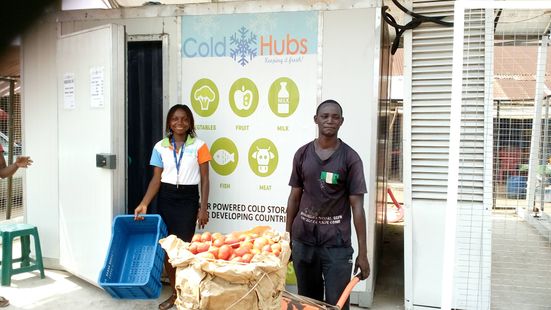Knowledge fuels change
For over a decade, Energypedia has shared free, reliable energy expertise with the world.
We’re now facing a serious funding gap.
Help keep this platform alive — your donation, big or small, truly matters!
Thank you for your support
ColdHubs - Solar Cold Rooms in Nigeria
Solar Cold Hubs
The innovative technology Cold Hubs is a modular, solar-powered walk-in cold room, for 24/7 off-grid storage and preservation of perishable foods. The system is designed to address the problem of post-harvest losses in fruits, vegetables and other perishable foods. Cold Hubs can be installed in major food production and consumption centers such as food markets. This technology allows for farmers to extend the freshness of their harvest from approx. 2 days to 21 days. The foods are placed in clean plastic crates which are stacked inside the cold room for a daily fee.
Background
Technology
The solar powered walk-in cold room is made of 120mm insulating cold room panels to retain the low temperature. Energy from solar panels mounted on the roof-top of the cold room are stored in high capacity batteries which feed an inverter which in turn feeds the refrigerating unit.
Food Security in Nigeria
Nigeria is the most populous country in Africa and the seventh most populous country in the world[1]. The agricultural sector contributes to 40 percent of Nigeria´s GDP and employs approximately two-thirds of the country’s total labour force[2]. However, there are many issues affecting the agricultural sector, leading to severe implications. Although 71 million hectares is estimated to be cultivable land, only half is currently used for farming. An additional issue is that merely 7 percent of irrigable land uses irrigation techniques: most of the small farms are depending on seasonal rainfall. These have however become more unreliable as climate change heavily affects the agricultural sector. Droughts are common in the north, while erosion and flooding are major problems in the south. [2] This increases the vulnerability of the population, particularly in rural areas[3].
In addition, lack of cold storage leads to enormous food losses in an already fragile situation. Although Nigeria produces 23 million tons of fresh fruit and vegetables each year, post-harvest losses reach up to 45 percent. This adds to the food insecurity in the country and leads to significant income losses for about 50 million smallholder farmers.
Poverty affects more than half the population with over 60 percent (around 110 million) living under the poverty line [1]. The lack of job opportunities is at the core of high poverty levels, of regional inequality, and of social and political unrest in the country[3].
The 2018 Global Hunger Index ranks Nigeria 103rd[4]out of 119 qualifying countries. With a score of 31.1[5], the severity in Nigeria is stated to be serious[6]. As such, Nigeria is one of the world's most food-insecure countries[7]. Population growth is further threatening the food production, as it demands more resources[2].
The Project
- ↑ 1.0 1.1 World Food Programme, “Nigeria” Accessed Sep. 25, 2019 https://www.wfp.org/countries/nigeria
- ↑ 2.0 2.1 2.2 Food Security Portal, “Nigeria”, Accessed Oct.10 2019 http://www.foodsecurityportal.org/nigeria/resources
- ↑ 3.0 3.1 World bank, “The World Bank In Nigeria”, Last modified Apr 09, 2019, Accessed Sep. 25 2019 https://www.worldbank.org/en/country/nigeria/overview
- ↑ Higher numbers indicates severer hunger situations.
- ↑ ≤9.9=Low, 10.0–19.9=Moderate, 20.0–34.9=Serious, 35.0–49.9=Alarming, ≥ 50.0=extremely alarming
- ↑ Global Hunger Index, “Nigeria”, Last modified 2019, Assessed Oct. 10 2019 https://www.globalhungerindex.org/nigeria.html
- ↑ Famine Early Warning Systems Network, „Acute Food Insecurity: Near Term (August-September 2019) “, Accessed Sep.25 2019. http://fews.net/




















